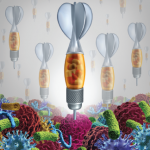“He has had tremendous influence, not only in developing clinical guidelines and developing measures to evaluate clinical activity, but also in developing a scientifically based training program in central Europe, and in terms of the politics of rheumatology, leading to recognition of rheumatology as a legitimate target of investment by the European Union,” says Dr. Lipsky. As Dr. Smolen’s protégés move into their own positions of authority, the network of rheumatologists nurtured by Dr. Smolen will continue to grow. “Even though I think people don’t like to leave the nest there in Vienna—it’s a very nice place—many of them are very talented and now moving into positions elsewhere in Europe and, I think, will continue that network,” says Dr. Lipsky.
“I think this interactive collaboration was one of his agendas when he became chairman of the department,” says Dr. Aletaha. “At the time, the department had a clear focus on basic research, and Dr. Smolen wanted to expand its scientific horizon and move into the field of outcomes research.”
Dr. Smolen continues a very busy schedule, traveling to meetings, supervising research, caring for patients, and staying active with national and international societies. Still, he finds time to relax with family and friends, enjoy concerts and the theater, and indulge in his hobby of collecting literature. (He has written a bibliography in German on a book series published in the early decades of the 20th century—Der jungste Tag.)
Dr. Smolen’s optimism has not dulled in the intervening years since his medical school pronouncements that change would come for RA patients. He always projects a positive attitude, says Dr. Aletaha. “It is always exciting to enter his office,” he continues, “and for some reason there’s always good news. I sometimes wonder, Where does he hide the bad news? Josef has an amazing way to motivate people.”
Gretchen Henkel writes the “Metrics in Rheumatology” series.
References
- Eberl G, Studnick A, Benke A, et al. Development of a disease activity index for the assessment of reactive arthritis (DAREA). Rheumatology (Oxford). 2000;39:148-155.
- Smolen JS, Breedveld FC, Schiff MH, et al. A simplified disease activity index for rheumatoid arthritis for use in clinical practice. Rheumatology (Oxford). 2003;42:244-257.
- Smolen JS, Kalden JR, Scott DL, et al. Efficacy and safety of leflunomide compared with placebo and sulphasalazine in active rheumatoid arthritis: A double-blind, randomized, multicenter trial. Lancet. 1999;353: 259-266.
- Emery P, Breedveld FC, Lemmel EM, et al. A comparison of the efficacy and safety of leflunomide and methotrexate for the treatment of rheumatoid arthritis. Rheumatology (Oxford). 2000;39:655-665.
- Strand V, Cohen S, Schiff M, et al. Treatment of active rheumatoid arthritis with leflunomide compared with placebo and methotrexate. Arch Intern Med. 1999;159: 2542-2550.
- Aletaha D, Nell VP, Stamm T, et al. Acute phase reactants add little to composite disease activity indices for rheumatoid arthritis: Validation of a clinical activity score. Arthritis Res Ther. 2005;7:R796-R806.
- Aletaha D, Smolen J. The Simplified Disease Activity Index (SDAI) and the Clinical Disease Activity Index (CDAI): A review of their usefulness and validity in rheumatoid arthritis. Clin Exper Rheum. 2005;23:S100-S108.

